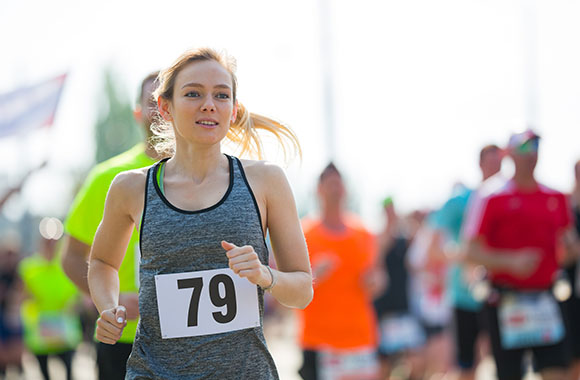Running training plan for beginners: How to reach your running goals
Once you’ve caught the running fever, you’ll want to start as soon as possible and start seeing results. Every runner sets different goals and follows a different training plan. It is important for people starting out to be clear about their own running goals: Do you want to improve your general fitness? Or to specifically improve your endurance and running speed? In this article, you can read about realistic running goals and plans for beginners and how to approach your goal step by step. We also briefly explain the difference between aerobic and anaerobic training.

Table of contents
Aerobic training and anaerobic training: What’s the difference?
When it comes to running training, you always read about aerobic and anaerobic training – but what do they mean?
The difference between “aerobic” and “anaerobic” training refers to the oxygen consumption during energy conversion in the body:
- Aerobic energy metabolism: to gain energy for muscle work, the body uses oxygen when burning carbohydrates and fats.
- Anaerobic energy metabolism: At higher levels of effort, carbohydrates are converted into energy through lactic acid fermentation without the consumption of oxygen.
This is how the two forms of energy metabolism differ during actual training:
| aerobic training | anaerobic training | |
| Intensity | low intensity with lower pulse range | high intensity with a higher pulse range |
| Nutrients burned | carbohydrates and fats | carbohydrates |
| Training goal | increase endurance, burn fat | build muscle, increase performance |
| Form of training | light endurance sport (e.g. jogging, swimming) | weight training, sprints, etc. |
Understanding the difference between the two types of training can help you better tailor your running training to your personal goal:
As a beginner, you should start your training at a lower intensity. As a guideline, you should still be able to talk to your running partner without getting short of breath. Your training will still be in the aerobic zone.
As a more experienced runner, you will realise that aerobic and anaerobic phases alternate depending on the intensity of your training. For many training goals, a combination of aerobic and anaerobic training is necessary.
Running plan for beginners: What training will suit your goal?
A running plan helps you keep track of your progress and goals. It is a good idea to set smaller realistic (partial) goals.
- Decide on your personal goal:g. get fitter, get faster, increase endurance, etc.
- Decide on your training frequency: Define how often you want to train per week. It is best to plan with fixed days and times.
- Plan rest, so your body can recover. This will help you avoid overloading your body.
- Think about the warm-up and cool-down during every training session and plan extra time for this.
For a better overview and motivation, keep a training diary. In it, you can record how you felt during certain training stages, what achievements you made and what other sub-goals you set for yourself.
For a better overview and motivation, keep a training diary. In it, you can record how you felt during certain training stages, what achievements you made and what other sub-goals you set for yourself.
1st training goal: Improve health and fitness
If your work is mainly sedentary or standing up, a casual run can be a welcome change from your daily routine. At the same time, it helps you become fitter: Running has a positive effect on the cardiovascular system, strengthens the bones and can even help reduce stress.
Running goal for beginners: Getting fitter
To increase fitness, even light, regular endurance training is enough. Two to three long runs per week are recommended.
- Set realistic goals and be consistent. If your goals are achievable, you will be more motivated to keep going. Slowly introduce your body to new challenges.
- Train extensively rather than intensively. Plan longer runs, i.e. medium to longer distances, but run them at a moderate pace.
- Build up your fitness gradually. As a beginner, you should train in the aerobic zone, i.e. you should still be able to talk to a running partner.
2nd training goal: Lose weight through running
The training goal “lose weight by running” is a classic goal with which many people want to bring a little change into their lives. For the best training results, you should ensure a balanced, healthy diet in addition to your training – a slight calorie deficit is advisable, but don’t starve yourself. Your health is always the priority.
Running goal for beginners: Reduce weight
Sustainable training success can be achieved by making gradual and sustainable changes.
- Endurance running in the aerobic zone helps you build up your endurance and supports fat burning. For beginners, it is important to work on base endurance first.
- To burn calories as effectively as possible, a mix of endurance and strength training is advisable. Vary the pace of your running and look for routes with some hills.
- Short training sessions with a high intensity boost the calorie burn and ensure a long “afterburn effect”. This means that calorie consumption is still increased for several hours after the run.
3rd training goal: Improve endurance and speed
New types of training and a varied running schedule will help you run longer and faster. First, train your endurance through easy endurance runs and then improve your speed and strength through technique exercises and intensive training sessions.
Running goal for beginners: Increase endurance and speed
Combine endurance runs and interval or tempo runs in your training plan to improve your speed.
- Increase the frequency of your training sessions, i.e. how often you run per week. Then you can increase the distance – and increase your speed as well.
- You can improve your running technique by practising coordination and technique exercises such as running ABC. This will make you run more efficiently and faster.
- To gradually get used to more effort using training such as speed play or interval training.
- High interval training (HIT) helps you to further increase your endurance and build muscle.

Even advanced runners with good basic endurance should add variety to their running training through different forms of training. New stimuli mean new challenges for the body, which is essential for sustained training success.
Even advanced runners with good basic endurance should add variety to their running training through different forms of training. New stimuli mean new challenges for the body, which is essential for sustained training success.
Training for a half or full marathon for beginners
For many runners, whether beginners or advanced, a marathon is a great goal to aim for. The distance of a marathon is 42.195 kilometres, while a half marathon covers around 21.1 kilometres.
For an absolute beginner, it may not be realistic to run a marathon after just a few months. Nevertheless, you can of course set yourself the half marathon as a longer-term goal. As long as you set smaller sub-goals and thus keep track of little successes along the way, that’s ideal for motivation. We have collected some of the most important information on the training goal of “running a marathon” for you here:
Half marathon and marathon for beginners: How fit do you have to be?
- For half or full marathon training you should be in good health. To be on the safe side, regular check-ups with your doctor are advisable, e.g. to rule out cardiovascular risks.
- To be able to run a half or full marathon, you should have one to two years of running experience. This means you already have a very solid basic endurance and are familiar with the technical basics.
- The prerequisite for training is that you can run 10 kilometres in one go and without any problems. This ensures that your body can withstand the increased load.
- Furthermore, you should already be able to complete a certain weekly training workload – for example, about 20 kilometres per week for a half marathon and about 30 to 40 kilometres per week for a marathon.
If you are working towards specific training goals such as a half or full marathon, in most cases you will need personalised guidance that fits your personal circumstances. Professional and experienced running coaches can help you with this. If you are looking for support and expert tips, you can also join a running group with a running coach in your area.
If you are working towards specific training goals such as a half or full marathon, in most cases you will need personalised guidance that fits your personal circumstances. Professional and experienced running coaches can help you with this. If you are looking for support and expert tips, you can also join a running group with a running coach in your area.
Conclusion
Improving endurance, increasing speed, losing weight, working towards a marathon – the reasons and goals for your running training can be very different and will certainly change throughout your running training. No matter what running goal you set for yourself: an achievable and concrete running plan for beginners is the best way to improve without injury. You can keep an eye on both your starting point and your goal, track your progress and set realistic subgoals. If you approach your running goals gradually, but with consistent improvement, you will also have more motivation and stamina.
References:
https://www.runnersworld.com/
(Accessed on 26.10.2021)
https://www.healthline.com/health/
(Accessed on 26.10.2021)
https://runnersworldonline.com.au/
(Accessed on 26.10.2021)
https://www.active.com/running/
(Accessed on 26.10.2021)
https://www.runnersworld.com/uk/
(Accessed on 26.10.2021)
Image sources:
iStock.com/svetikd
iStock.com/amriphoto
iStock.com/Pheelings Media






